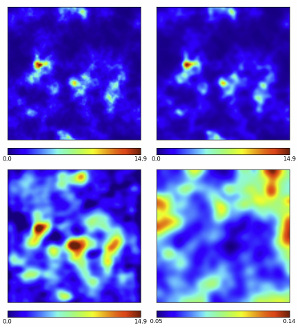|
|  |
Using radio interferometers, scientists look into the deepest depths
of the Universe. These instruments deliver high-resolution images of
many different celestial objects, ranging from the Sun, over pulsars,
and the interstellar gas in the Milky Way, to distant sources such as
radio galaxies or quasars. The high-resolution radio images of such
objects often reveal their complex and extended structure.
Indeed, most of the radio emission from celestial sources originates
in extended cosmic plasma clouds, glowing only faintly to the observer
on Earth. In consequence, such extended regions of emission are
difficult to detect, since they have to be separated from unwanted
interferences as e.g. electronic noise from terrestrial technical
equipment or atmospheric effects.
Furthermore, imaging in radio interferometry is inherently more
complicated as for a single telescope. This is because an
interferometer does not detect the celestial sources directly, instead
the signals from different detectors are electronically
superimposed. To reconstruct the original signal from the data, a so
called Fourier transformation needs to be applied, usually implying
complex calculations on the computer. Unfortunately, standard imaging
methods have the drawback that they often only produce unreliable
results for weak and extended emission. Moreover, due to the complex
nature of the interferometric observation, in general an estimation of
the measurement uncertainty was unreliable so far as well.
In two recent publications, the new imaging algorithm RESOLVE ("Radio
Extended Sources Lognormal Deconvolution Estimator") is presented to
solve exactly these problems of current methods. RESOLVE employs a
statistical approach, estimating the most probable image
reconstruction compatible with the measured data. In this process, the
algorithm uses the vague prior knowledge of the observer on the source
— namely that it is an extended object — to differentiate
between likely and unlikely reconstructions. To this end, RESOLVE
assumes that the radio intensity does not change abruptly from one
place to the next, but instead that the source is comprised of
statistically similar structures, connected over several pixels, and
not necessarily exactly known prior to an observation. Mathematically,
this is expressed by a so-called spatial correlation function, unknown
at the beginning of the reconstruction process.
RESOLVE can roughly be divided into two major steps. In the first
part, the statistically most probable image reconstruction, compatible
with an extended source, is estimated. In this step, the spatial
correlation function is assumed to be known by the algorithm and thus
influences the reconstruction process. In the second part, the
correlation function is estimated using the intermediate image
reconstruction obtained in the first step. RESOLVE iterates this
two-step process until a statistically optimal reconstruction has been
obtained. Finally, from the last reconstruction, a map of the
measurement uncertainty is calculated.
This procedure can be extended to observations at different
wavelengths. For this, in addition, the spectral dependence of the
radio emission in every pixel is estimated using a very similar method
as just described.
Simulated reconstructions using RESOLVE show that from high quality
interferometric data, it is indeed possible to computationally reverse
the complicated measurement process of the interferometer with high
precision and to estimate the structure of an extended radio source with
high precision. In addition, the noise is removed from the measured
signal and a measurement uncertainty is estimated during this process.
Possible areas of application in observational radio astronomy range
from single objects in the Milky Way like e.g. remnants of exploding
stars, to distant radio galaxies and large galaxy clusters. The new
image reconstructions will allow for a deeper and better resolved view
into the radio sky.
Henrik Junklewitz, Michael Bell and Torsten Enßlin
REFERENCES
Henrik Junklewitz, Michael Bell, Marco Selig and Torsten Enßlin,
"RESOLVE: A new algorithm for aperture synthesis imaging in radio astronomy",
submitted to A&A
 http://arxiv.org/abs/1311.5282 http://arxiv.org/abs/1311.5282
Henrik Junklewitz, Michael Bell and Torsten Enßlin,
"A new approach to multi-frequency imaging in radio interferometry",
submitted to A&A
 http://arxiv.org/abs/1401.4711 http://arxiv.org/abs/1401.4711
|


